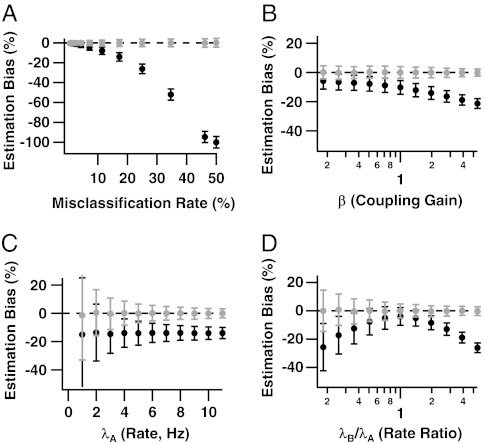Fig. 3.
Relative biases of coincidence rate estimates from traditional and ensemble sorting, (T⊥ - θ)/θ (black) and  (gray), as functions of (A) the spike misclassification rate due to overlapping waveform clusters, (B) the coupling strength β, (C) the spike rate λA, and (D) the rate ratio λB/λA. The x axes of B and D are on a logarithmic scale. In each panel, parameters held constant are μ = 2 (17.3% misclassified spikes), λA = 4 Hz, λB/λA = 3, and β = 2. Ensemble sorting (gray) always yields unbiased estimates. Traditional sorting (black) never does, except when cells are independent and have equal rates (Theorem 1.1), or when waveform clusters are fully separated (Theorem 1.1 and Fig. 3A, zero error rate). Otherwise, the bias of T⊥ increases as the waveform clusters overlap (Fig. 3A), the coupling strength increases (Fig. 3B), and the firing rates differ (Fig. 3D).
(gray), as functions of (A) the spike misclassification rate due to overlapping waveform clusters, (B) the coupling strength β, (C) the spike rate λA, and (D) the rate ratio λB/λA. The x axes of B and D are on a logarithmic scale. In each panel, parameters held constant are μ = 2 (17.3% misclassified spikes), λA = 4 Hz, λB/λA = 3, and β = 2. Ensemble sorting (gray) always yields unbiased estimates. Traditional sorting (black) never does, except when cells are independent and have equal rates (Theorem 1.1), or when waveform clusters are fully separated (Theorem 1.1 and Fig. 3A, zero error rate). Otherwise, the bias of T⊥ increases as the waveform clusters overlap (Fig. 3A), the coupling strength increases (Fig. 3B), and the firing rates differ (Fig. 3D).

